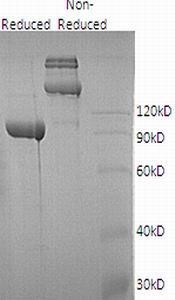Recombinant Human PDCD1/PD-1/CD279 (C-6His)(Discontinued)
Shipping Info:
For estimated delivery dates, please contact us at [email protected]
| Amount : | 50 µg |
| Content : | Lyophilized from a 0.2 µm filtered solution of 20mM PB,150mM NaCl,pH7.2. |
| Storage condition : | Lyophilized protein should be stored at -20°C, though stable at room temperature for 3 weeks. Reconstituted protein solution can be stored at 4-7°C for 2-7 days. Aliquots of reconstituted samples are stable at -20°C for 3 months. |
| AA sequence : | LDSPDRPWNPPTFSPALLVVTEGDNATFTCSFSNTSESFVLNWYRMSPSNQTDKLAAFPEDRSQPGQDCRFRVTQLPNGRDFHMSVVRARRNDSGTYLCGAISLAPKAQIKESLRAELRVTERRAEVPTAHPSPSPRPAGQFQHHHHHH |
Source: Human Cells.
MW :17kD.
Recombinant Human Programmed Cell Death Protein 1 is produced by our Mammalian expression system and the target gene encoding Leu25-Gln167 is expressed with a 6His tag at the C-terminus. Programmed cell death protein 1(PDCD1) is a single-pass type I membrane protein and contains 1 Ig-like V-type domain. PD-1 is a member of the extended CD28/CTLA-4 family of T cell regulators. PDCD1 inhibits the T-cell proliferation and production of related cytokines including IL-1, IL-4, IL-10 and IFN-g by suppressing the activation and transduction of PI3K/AKT pathway. In addition, coligation of PDCD1 inhibits BCR-mediating signal by dephosphorylating key signal transducer. PDCD1 has been suggested to be involved in lymphocyte clonal selection and peripheral tolerance, and thus contributes to the prevention of autoimmune diseases. As a cell surface molecule, PDCD1 regulates the adaptive immune response. Engagement of PD-1 by its ligands PD-L1 or PD-L2 transduces a signal that inhibits T-cell proliferation, cytokine production, and cytolytic function.
MW :17kD.
Recombinant Human Programmed Cell Death Protein 1 is produced by our Mammalian expression system and the target gene encoding Leu25-Gln167 is expressed with a 6His tag at the C-terminus. Programmed cell death protein 1(PDCD1) is a single-pass type I membrane protein and contains 1 Ig-like V-type domain. PD-1 is a member of the extended CD28/CTLA-4 family of T cell regulators. PDCD1 inhibits the T-cell proliferation and production of related cytokines including IL-1, IL-4, IL-10 and IFN-g by suppressing the activation and transduction of PI3K/AKT pathway. In addition, coligation of PDCD1 inhibits BCR-mediating signal by dephosphorylating key signal transducer. PDCD1 has been suggested to be involved in lymphocyte clonal selection and peripheral tolerance, and thus contributes to the prevention of autoimmune diseases. As a cell surface molecule, PDCD1 regulates the adaptive immune response. Engagement of PD-1 by its ligands PD-L1 or PD-L2 transduces a signal that inhibits T-cell proliferation, cytokine production, and cytolytic function.
Always centrifuge tubes before opening. Do not mix by vortex or pipetting. It is not recommended to reconstitute to a concentration less than 100 µg/ml. Dissolve the lyophilized protein in ddH2O. Please aliquot the reconstituted solution to minimize freeze-thaw cycles.
Endotoxin : Less than 0.1 ng/µg (1 IEU/µg) as determined by LAL test.
For Research Use Only. Not for use in diagnostic/therapeutics procedures.
| Subcellular location: | Membrane |
| BioGrid: | 111160. 61 interactions. |
|
There are currently no product reviews
|
















.png)








